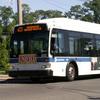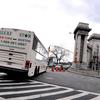Jim O'Grady appears in the following:
NY MTA Wants Apps on Getting Around, But Key Data Still Hidden
Monday, December 05, 2011
MTA Countdown Clock Photo (Kate Hinds)
The MTA has launched a contest for software applications that help riders get around by subway, bus or train. But the authority is still not releasing certain important information.
The MTA used to make it hard for app developers to get access to things like train schedules and how many straphangers go through the turnstiles at each station. That changed in January 2010, after pressure from developers, when the authority put mountains of data online.
But the MTA hasn't shared data collected by countdown clocks that report the actual time a train will arrive, instead of the scheduled time. Having that kind of real-time information would make many apps more accurate.
MTA spokesman Aaron Donovan said the authority knows the data is desirable but there's no plan for releasing it except that "it's on our to-do list." An MTA staff member who didn't want to be identified said the authority's priority is to add more countdown clocks and put GPS devices on city buses to let riders know when the next bus will reach their stop.
In the meantime, here's some information on The MTA App Quest, which offers $15,000 in prizes to apps that best “improve the transit experience” for the region’s 8.5 million riders. Members of the public can vote on the 42 competing apps, which range from quirky to clever to new age and newfangled.
Read our previous coverage of the competition here.
MTA Wants Riders to Vote on City's Next Best Transit App
Monday, December 05, 2011

The MTA has launched a contest for software applications that help riders get around by subway, bus or train. It's a sign of how the MTA has become better about sharing data, but the authority is still keeping some important information to itself.
Last Option in Transit-Poor Red Hook Suffers Delays, Overcrowding
Sunday, December 04, 2011
Riders on the B-61 (photo courtesy City Councilmber Brad Lander)
The B61 bus is the sole transit lifeline for residents of Red Hook, Brooklyn. But a report by two Brooklyn elected officials says the buses don't come often enough and bunch up when they do.
The report says the B61 arrives on time during rush hour only 43 percent of the time. And buses can be so full that they routinely skips stops, leaving passengers stranded. City Councilmember Brad Lander says neighborhoods like Red Hook with no subway need more reliable bus service. "There's only one bus line that goes there right now, " Lander says. "The B61 is the only transit way in or out."
The MTA cut costs last year by eliminating three bus lines serving Red Hook and nearby neighborhoods. Some residents adapted by walking to the closest subway stop at Smith and 9th Streets. But with that stop now undergoing a year-long renovation, many Red Hook commuters have been force to use the problem-plagued B61.
The report, by Councilman Lander and Congresswoman Nydia Velasquez urges the MTA to add express buses during peak hours that are equipped to hold green lights in their favor to get riders quickly to subway stops during rush hour.
The MTA says it's reviewing the report.
Straphangers Campaign Says M50 Bus Is Slowest of Them All
Thursday, December 01, 2011

The Straphangers Campaign is out with its annual Pokie Award, and the "winner" is the M50 bus.
The M50 is Slowest Bus In New York: You Can Walk Faster
Thursday, December 01, 2011
(New York, NY - WNYC) The Straphangers Campaign is out with its annual Pokie Award, and the "winner" is the M50 bus.
Every year, the group gives out two awards for poor bus service: the Pokie, for the slowest bus, and the Schleppie, for the least reliable.
The advocacy group said it clocked the M50 -- which runs crosstown between the United Nations on the East Side of Manhattan to Pier 43 on the Hudson River-- at noon at an average speed of only 3.5 miles per hour.
"The bus is just tremendously slow," said Straphangers spokesman Gene Russianoff. "You can push a lawnmower faster across Midtown than it takes the M50 to go from First to Second Avenue."
Russianoff said that though the M 50 is particularly desultory, the city's bus system is plagued by plodding speeds as it makes 2.5 million trips on an average weekday. "That's a lot of people stuck in traffic who deserve quicker trips," he said.
The Straphangers Campaign gave its Schleppie Award to the M 101, 102 and 103 buses on the Upper East Side of Manhattan for arriving in bunches and failing to meet their schedules. He said those lines could move faster if the city protected them from traffic with dedicated lanes and sped up boarding by having passengers pay beforehand at bus stop kiosks--as is the case with Select Bus Service on the 34th Street crosstown route.
The NY Metropolitan Transportation Authority agrees, in concept."The past year established Select Bus Service as a game changer in New York, with 20 percent faster bus service now on three routes," said MTA spokesman Kevin Ortiz. "We are working with the city to expand the SBS network, bringing faster boarding, dedicated bus lanes and enhanced bus lane enforcement to more and more routes."
The city's bus system has absorbed some blows in recent years. The NY MTA cut 37 bus lines and shut down 570 bus stops as a cost-saving measure in June 2010. And while subway ridership has grown over the past two years, bus ridership is down by nearly two percent.
MTA statistics show that breakdowns on city buses have increased by 12% since last year. And the percentage of city buses that are 12 years or older has more than doubled, from 16% of the bus fleet in 2010 to 35% in 2011.
Millions Come Out to Watch Macy's Thanksgiving Day Parade
Wednesday, November 23, 2011
There were some new balloons this year in Macy's Thanksgiving Day parade. Paul Frank's sock puppet-inspired simian Julius made its debut in front of millions of spectators Thursday, as did fellow newcomer B., a freakish creation from filmmaker Tim Burton.
Funding Dispute Could Delay Opening of 9/11 Museum
Monday, November 21, 2011

The 2012 opening of the National September 11 Memorial & Museum at the World Trade Center could be delayed because the museum and the Port Authority of New York and New Jersey are arguing over funds.
NY MTA And Its Largest Union Open Contract Talks
Tuesday, November 15, 2011
TWU Local 100 president John Samuelsen chats with MTA executive director Joe Lhota before the start of contract talks at the Sheraton Hotel. (Photo by Jim O'Grady)
Listen to an audio version of this story:
(New York, NY - WNYC) The NY Metropolitan Transportation Authority and its largest union opened contract talks on Tuesday at the Sheraton Hotel in Midtown Manhattan. Both sides acknowledged tense times ahead.
The MTA said it is counting on its workers to accept a three-year wage freeze like the one Governor Andrew Cuomo extracted from the Public Employees Federation. But John Samuelsen, president of Transport Workers Union Local 100, said he and his members won't buckle if the MTA tries to do the same. Samuelsen said, "We're certainly not going to be bullied into accepting wage freezes by threat of layoff."
The current contract expires January 15.
Negotiations began with addresses by Samuelsen and MTA executive Joe Lhota to a conference room packed with TWU members. Lhota started with a compliment: "My first message to you is that I know the MTA employees are our most valuable resource."
The remark was in some ways pro forma. But its reception by the workers — hearty roars filled the room — seemed to signal something new between the authority and the union: a measure of mutual respect. Samuelson said he never felt that from Lhota's predecessor, Jay Walder, who fought with the union and laid off 1,000 workers in 2009. When Walder announced his resignation this past July, the TWU began its official statement by saying the union was "glad to see him go" -- and it went downhill from there.
Lhota, who started on the job Monday, shrewdly made his first act in office to join the union's call for aggressive prosecution of attacks on bus drivers. The union says someone assaults a bus driver an average of three times a week in New York. Lhota reiterated the stance at the Sheraton, to more applause.
He then switched to the matter at hand and declared, "As we begin the collective bargaining process, you have my commitment that the MTA will listen to your demands and that we will negotiate in good faith."
On the surface, the two men anchoring each side in the contract talks are opposites: Lhota wears an executive's suit and looks owlish behind thick glasses; Samuelsen is a bear of a man in an untucked union polo shirt.
But they seem to have gotten off to a good, if wary, start. When Samuelsen brought Lhota to the podium at the Sheraton, he asked his members not to boo. They didn't.
And when the meeting was done, the union chief made another unusual request of the crowd as Lhota and his deputies were leaving. "Please show respect for the bosses who are walking out of here right now," Samuelsen said. "We'll save our fight for another day."
Fighting there will be. Lhota cautioned that the MTA's budget was "fragile" due to "the ongoing economic crisis." Samuelsen countered that its members have increased their productivity in recent years and deserve a raise. Talks begin in earnest in a week or two.
The MTA and its largest union opened contract talks on Tuesday at the Sheraton Hotel in Midtown Manhattan. Both sides acknowledged tense times ahead.
The MTA said it is counting on its workers to accept a three-year wage freeze like the one Governor Andrew Cuomo extracted from the Public Employees Federation. But John Samuelsen, president of Transport Workers Union Local 100, said he and his members won't buckle if the MTA tries to do the same. Samuelsen told WNYC's Brian Lehrer, "We're certainly not going to be bullied into accepting wage freezes by threat of layoff."
The current contract expires January 15.
Negotiations began with addresses by Samuelsen and MTA executive Joe Lhota to a conference room packed with TWU members. Lhota started with a compliment: "My first message to you is that I know the MTA employees are our most valuable resource."
The remark was in some ways pro forma. But its reception by the workers — hearty roars filled the room — seemed to signal something new between the authority and the union: a measure of mutual respect. Samuelson said he never felt that from Lhota's predecessor, Jay Walder, who fought with the union and laid off 1,000 workers in 2009. When Walder announced his resignation this past July, the TWU constructed its official reaction around the phrase "good riddance."
Lhota, who started on the job Monday, shrewdly made his first act in office to join the union's call for aggressive prosecution of attacks on bus drivers. The union says someone assaults a bus driver an average of three times a week in New York. Lhota reiterated the stance at the Sheraton, to more applause.
He then switched to the matter at hand and declared, "As we begin the collective bargaining process, you have my commitment that the MTA will listen to your demands and that we will negotiate in good faith."
On the surface, the two men anchoring each side in the contract talks are opposites: Lhota wears an executive's suit and looks owlish behind thick glasses; Samuelsen is a bear of a man in an untucked union polo shirt.
But they seem to have gotten off to a good start. When Samuelsen brought Lhota to the podium at the Sheraton, he asked his members not to boo. They didn't.
And when the meeting was done, the union chief made another unusual request of the crowd as Lhota and his deputies were leaving. "Please show respect for the bosses who are walking out of here right now," Samuelsen said. "We'll save our fight for another day."
Fighting there will be. Lhota cautioned that the MTA's budget was "fragile" due to "the ongoing economic crisis." Samuelsen countered that its members increased productivity in recent years and deserve a raise. Talks begin in earnest in a week or two.
MTA And Its Largest Union Open Contract Talks
Tuesday, November 15, 2011

The MTA and its largest union opened contract talks on Tuesday at the Sheraton Hotel in Midtown Manhattan. Both sides acknowledged tense times ahead.
Long Island Bus To Privatize
Friday, November 11, 2011
On Jan 1, Long Island Bus will change its name to NICE, and get a new look.
(New York, NY - WNYC) Nassau County Executive Edward Mangano held a press conference in a Garden City bus garage to announce that Veolia Transportation, a private company, will assume operations of Long Island Bus from the NY Metropolitan Transportation Authority on January 1.
On that day, the bus service's name will be changed to "NICE," an acronym for Nassau Inter-County Express. The buses will also sport a new orangey look (see photo above).
Mangano says the move will reduce Nassau's yearly subsidy to the service from $9 million, which it was paying to the NY MTA, to $2.26 million. He said Veolia would keep fares the same in 2012, which is not a savings for riders because the NY MTA wasn't planning on raising them. If Veolia wanted to raise fares after that, Mangano said the company would need approval from a new 5-member Bus Transit Committee made up of Nassau County residents.
Veolia would keep the line's 48 routes, at least to start. But Mangano said efficiency of service might mean "consolidating" routes in the future.
"Veolia's responsibility is to continue to run an efficient bus service, monitoring routes and ridership so there's no waste," Mangano said. "Minimize waste, maximize efficiency--that's how we keep bus service affordable here in Nassau County."
Mangano said the contract between Nassau and the company has been sent to the county legislature for approval. It was not provided to the press or public. Beyond assurances that Veolia can run the line more efficiently than the NY MTA, it is unclear how the company will turn a profit on such a relatively small subsidy.
It is also not yet known whether riders will be able to pay with a Metrocard, as they've been doing, or if Veolia will have to institute a new payment system. And Nassau County riders who cross the border into Queens could lose the free transfer to a NY MTA bus that they currently enjoy. Mangano said the county is negotiating with the NY MTA to maintain both arrangements.
Patricia Bowden, president of Transport Workers Union Local 252, talked to reporters after the press conference. She said her members--bus drivers, dispatchers, mechanics and others--face uncertainty in the switch from the NY MTA to Veolia. She added that the union offered to work with Nassau County Executive Edward Mangano to help manage the transition, but were rebuffed.
"Ed Mangano did not sit down with us," she said. "To this day, he ignores Transport Workers Union Local 252. We haven't even seen the contract."
Bowden said she expects privatization to thin the ranks of the 981-member workforce and that workers will face cuts in benefits.
Long Island Bus To Privatize
Thursday, November 10, 2011

Nassau County Executive Edward Mangano held a press conference in a Garden City bus garage to announce that Veolia Transportation, a private company, will assume operations of Long Island Bus from the NY Metropolitan Transportation Authority on January 1.
NY State Comptroller: Workers Cheat Metro-North Railroad Out Of Millions
Thursday, November 10, 2011
(New York, NY - WNYC) Metro-North Railroad supervisors signed their own fraudulent time cards, workers were paid for travel to job sites they never went to and day-shift employees were put on late shifts that required them to rest the next day, at full pay. In the end, a report by New York State Comptroller Thomas DiNapoli says, 28 of 30 employees in the railroad's signal construction unit racked up more than $1.2 million in overtime and regular pay--and $5.5 million in future pension pay.
The report said that supervisors also tried to hide the abuses, most of which involved overtime, by shifting payroll costs to unrelated projects.
DiNapoli told Transportation Nation that the findings, and what they say about the NY Metropolitan Transportation Authority's management of the railroad, are disturbing. "It really gets to a culture of tolerance and acceptance of practices that really don't make any sense from a cost point of view at a time when the MTA very much needs to be more efficient and not waste money," he said.
The report said the most common abuse by the unit was to take advantage of a federal rule that requires railroad employees to rest for ten hours after working 12 hours, which was designed to prevent riders from being placed in the hands of fatigued motormen and other equipment operators.
Auditors in DiNapoli's office found supervisors assigned day workers to a 12-hour night shift, at overtime pay, that required them to rest the next day while being paid their regular wage. The report said one worker pulled the maneuver enough times that his lifetime pension benefits are now $1.5 million more than they would have been based on base salary alone.
"These payments occurred because of a pervasive culture of management acceptance of long-term practices, employee feelings of entitlement to additional compensation, and ineffective internal controls in Metro-North’s payroll office," the report stated.
The NY MTA said its audit department is tightening payroll controls and cooperating with an investigation by the authority's inspector general. The authority also issued a statement that said, in part, "Metro-North took steps last summer to ensure that signal supervisors no longer sign their own timecards."
Comptroller DiNapoli: Railroad Workers Cheat Metro-North Out Of Millions
Wednesday, November 09, 2011

An audit of the MTA reveals there was systemic abuse of overtime and the payroll system that will cost the state millions.
NYC Subway Riders' Worry: Service Slipping Back To The Bad Old Days
Monday, November 07, 2011
(New York, NY - WNYC) New York City Transit suffered its third derailment in six months on October 24, when two train cars on the 6 train jumped the tracks near the Brooklyn Bridge-City Hall Station. That's the kind of major breakdown that tends to make riders wonder, could the subway be sliding backward toward the dark days of the 1970's? That's when crime and train breakdowns, among other ills, were common. And that was before a major investment in repairs and construction rescued it from the brink.
Amber Morgan, 42, has been riding the subway for 37 years. Standing on a platform at Union Square Station, she talked about how she'd seen the subway improve after a stretch of very lean years.
"It's better than it was in the ‘70s," she said. "I have memories of the subway when it was covered with graffiti and it was not safe. It's a different subway then when I was a kid."
But Morgan acknowledged she'd moved from Williamsburg to Manhattan because she and her husband didn't want to rely on the L train any more. And she worried it could get worse. "If they keep cutting the budget and keep raising the fare, less people will be able to ride it and it won't be as reliable," she said.
Budget cuts have made some things worse. Recent NY MTA data show a 20 percent increase in trains arriving more than five minutes late at the end of their runs. But New York City Transit President Tom Prendergast said major service disruptions — like those caused by derailments — are not worsening because of belt-tightening
"We do not think it's in any way related to budget issues or financial issues," he said. "We treat every derailment very seriously. I mean, I was here at a point in time twenty years ago, when we had 27 derailments a year."
Surprisingly, Gene Russianoff of the Straphangers Campaign agrees with Prendergast. He said the NY MTA's average of less than two derailments per year over the last five years is not bad. But Russianoff added delays and overcrowding are other matters.
"You know, it's not the bad old days yet," he said. "But you have to worry about going down the slippery slope."
There's reason for that concern. One big cause for weekday delays is overcrowding. Ridership is up since last year, when the MTA cut costs by eliminating and combining lines, and putting many trains on less frequent schedules.
Joe Sirefman, 81, was about to catch an uptown 1 train in the West Village an a bright fall afternoon. He's a native New Yorker who's ridden the subway his whole life. The increased crowding reminds him of what it was like to squeeze into a packed 6 train as a kid.
"I remember in the summertime hearing, 'Another shove, Madame, and I'll have to marry you,’" he said.
The MTA used to schedule its weekend and overnight trains to run often enough for every rider to have a seat. But with cutbacks, one in five riders is now expected to stand. Factor in delays and cars can get crowded.
Still, there are bright spots. A 1 train rider named Carol said things aren't as bad as before. "It's gotten better," she said. "The information that's given to us — the countdown clocks, the signs and all of that."
It seems that, if riders must be delayed, it helps to know for how long.
Subway Riders' Worry: Service Slipping Back To The Bad Old Days
Monday, November 07, 2011

Layoffs Announced For 981 Long Island Bus Workers
Wednesday, November 02, 2011
 (New York, NY - WNYC) The New York State Labor Department has given notice that 981 Long Island Bus workers could be laid off on New Year's day. The move is a precautionary step in case suburban Nassau County fails in its effort to privatize a bus line that the NY Metropolitan Transportation Authority now runs. But the uncertainty is causing concern among the bus service's work force, and its 100,000 weekday riders.
(New York, NY - WNYC) The New York State Labor Department has given notice that 981 Long Island Bus workers could be laid off on New Year's day. The move is a precautionary step in case suburban Nassau County fails in its effort to privatize a bus line that the NY Metropolitan Transportation Authority now runs. But the uncertainty is causing concern among the bus service's work force, and its 100,000 weekday riders.
The NY MTA has been running Long Island Bus for years. But Nassau County balked last year when the authority asked it to pay $26 million dollars more per year for the service, which the NY MTA says would bring Nassau in line with what Suffolk and Westchester counties pay for similar services.
Instead, Nassau County entered into talks with private company Veolia Transportation to take over the line's operation. No agreement has been reached.
Katie Grilli-Robles, a spokeswoman for County Executive Edward Mangano, said there should be an agreement soon. "The administration will be forwarding a contract to the Legislature in the coming days that saves taxpayers $26 million annually, while restoring the NY MTAs planned route cuts and maintaining fares," Grilli-Robles told Transportation Nation.
In the meantime, the NY MTA was required to give the Labor Department 60-day notice that it will be laying off all of the line's workers when the clock strikes midnight on the last day of the year.
NY MTA spokesman Kevin Ortiz said, "We are following procedural requirements to facilitate the handover of Long Island Bus at the end of the year, consistent with the county's decision to privatize operations on January 1."
Transport Workers Union spokesman Jamie Horwitz said having no operator in place to run Long Island Bus on January 1 was provoking anxiety in both workers and riders. "The second wealthiest county in the United States shouldn't be placing the elderly, the disabled, commuters, and students in limbo as far as public transportation," he said.
Horwitz said the union was in talks with Veolia about retaining much of the current workforce should the company get the contract to run the line.
But already, the union and the county are squaring off on what obligation the county has to current LI bus workers.
Horwitz said that if Veolia were to hire union workers at wages and benefits below their current levels, the county would be required by law to make up the difference over the next six years.
"Not true," said Grilli-Robles.
Stay tuned.
Layoffs Announced For 981 Long Island Bus Workers
Wednesday, November 02, 2011

The New York State Labor Department has given notice that 981 Long Island Bus workers could be laid off on New Year's Day. The move is a precautionary step, in case Nassau County fails in its effort to privatize a bus line that the MTA now runs. Still, the uncertainty is causing concern among the bus service's work force, and its 100,000 average weekday riders.
Small, Curbside Bus Companies Have More Accidents: Report
Monday, October 31, 2011

So-called "Chinatown buses" that pick up and drop off passengers at the curb have more fatal accidents and fail more inspections than larger carriers, according to a report by the National Transportation Safety Board. And curbside carriers with ten or fewer buses that have been in business less than ten years tend to have the worst safety records of all.
Fed Study Says Small Curbside Bus Companies Have More Accidents
Monday, October 31, 2011
(New York, NY - WNYC) So-called "Chinatown buses" that pick up and drop off passengers at the curb have more fatal accidents and fail more inspections than traditional larger carriers who operate out of bus terminals, according to a report by the the National Transportation Safety Board. Curbside carriers with fleets of ten or fewer buses that have been in business less than ten years tend to have the worst safety records of all.
The report, which begins by saying long distance bus travel remains generally safe, was prompted by an accident in the Bronx in March that killed 15 passengers.
A bus operated by World Wide Travel was returning to New York City from the Mohegan Sun Casino in Connecticut when it rolled on its side and hit the support pole for a highway sign. Investigators say driver Ophadell Williams was fatigued when the accident occurred at 5:37 a.m.
Williams, awaiting trial, has been charged with fifteen counts of manslaughter.
The report says driver fatigue is a major issue for "Chinatown" buses. It adds that buses leaving from a curb at various street locations are harder to track down and inspect than buses that use terminals. The report also says the Federal Motor Carrier Safety Administration, which performs the inspections, has been overwhelmed by the rapid growth of the long distance bus industry, and that there are 1.15 inspectors for every 1,000 bus companies.
And there's a problem, the report says, with bus companies that inspectors put out of service for violations but which then "reincarnate" under a different name while selling tickets through the same online broker they used before.
"The NTSB report is a wake-up call that we need a more rigorous regulatory regime and it provides a blueprint for how to fill the gaps," said U.S. Senator Charles Schumer at a press briefing (video) held in New York this morning to about the report.
The Chinatown bus industry has grown rapidly over the last several years, even as it has been plagued by safety issues. "The fatal accident rate for curbside carriers from January 2005 to March 2011 was seven times that of conventional carriers," the report says.
Elite Universities Vying For NYC Tech Campus Opportunity
Friday, October 28, 2011
The deadline for universities to submit their bids to open a new engineering school in the city with the help of the Bloomberg administration is today.

















